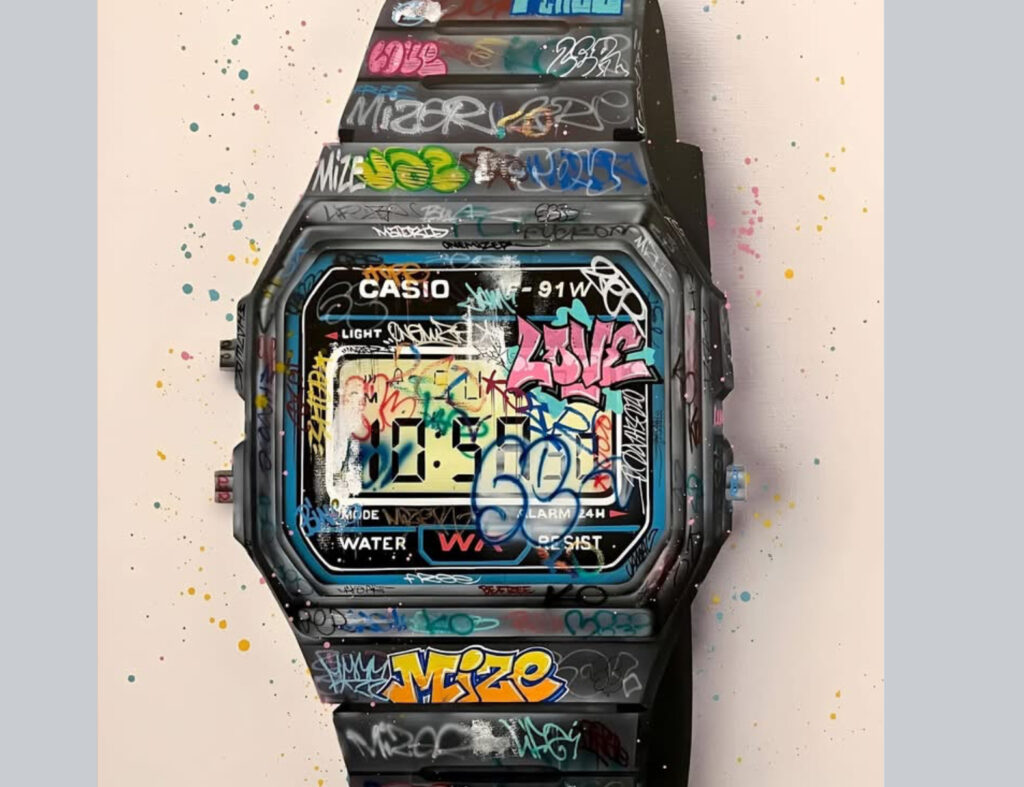There are objects so common they become invisible. A plastic Casio wristwatch—model F-91W—is one of them. Ubiquitous, unassuming, and cheap. Worn by schoolkids, laborers, minimalists, and soldiers. It’s not fashion. It’s function. A tool to tell time. A utility device priced to disappear.
But in this image—painted, defaced, reimagined—it becomes something else.
The watch is no longer invisible. It’s vandalized. Embellished. Saturated with tags, color, and coded messages. A symbol of utility overwritten by the chaos and charisma of graffiti. The Casio becomes canvas, and time itself becomes something messier: not precision, but perception.
This isn’t just street art. It’s cultural commentary, sprayed in layers.
FROM TOOL TO TOTEM
Casio’s F-91W is the kind of object designed to stay out of the way. It’s been worn by millions who didn’t give it a second thought. But its blankness—its industrial neutrality—is exactly what makes it the perfect surface for subversion.
In the image, graffiti artists don’t just decorate the watch—they reclaim it. The numbers on the screen are barely visible, layered over with names, tags, symbols. “LOVE,” “MIZE,” “302”—markers of presence. Statements of identity.
Suddenly, this mass-produced machine isn’t keeping track of hours. It’s keeping track of expression. It’s become a street artifact—a timepiece that doesn’t just mark the time, but marks its moment in visual noise.
THE LANGUAGE OF LAYERS
Graffiti is never about a single artist. It’s about the accumulation—the layering of voices over time. One tag leads to another. A throw-up gets buffed and rewritten. Each layer is a message, a challenge, a piece of dialogue shouted in color.
This image mimics that dynamic. The watch is overwhelmed with tags, paint splatter, drips. There’s no hierarchy, no focal point. It’s a visual clash, like a city wall that’s been hit for a decade straight without being wiped. The chaos is the point. Everyone gets a voice, even if it’s temporary.
And that’s the essence of graffiti: temporality. The impermanence of marks. The refusal to be curated. Like time itself, it moves, fades, and returns—always rewritten.
FUNCTIONALITY VS. FREEDOM
A wristwatch promises order. It segments our day into clean pieces. It creates boundaries. It governs.
Graffiti promises rupture. It spills over borders. It resists time slots and sanctioned space. It’s anarchic, democratic, and endlessly improvised.
So to tag a watch is to stage a conflict between these worldviews. Do you measure time, or do you disrupt it? Are you punctual, or present?
The artists here seem to reject the idea that time must be clean, measured, digitized. They flood the screen. They blur the boundaries. They reclaim the watch not as a device—but as a statement.
THE WATCH AS ICON
Let’s not forget: the F-91W isn’t just any watch. It’s a symbol. Its simplicity has made it both loved and notorious. Worn by schoolchildren in Tokyo, rebels in Palestine, and even reportedly by members of extremist groups (according to declassified documents), it’s become a silent witness to every kind of life.
To paint it is to engage that history. To say: this tool means more than you think it does. It’s everywhere. And so is graffiti.
Graffiti, like the Casio, is global. It lives in every alley, under every bridge, on every abandoned train car. It is the voice of the ignored, the restive, the uninvited. When these two global signifiers collide—a street tag and a street tool—it feels strangely perfect.
REVALUING THE ORDINARY
There’s a kind of inverted luxury at work here. A Casio is cheap. Graffiti is often criminalized. But together, they create something priceless—not in money, but in meaning.
Art, after all, isn’t about materials. It’s about context, tension, intention. A diamond-encrusted Rolex may scream wealth. But a tagged-up Casio whispers something deeper: that the street finds a way to speak, even on the surfaces no one expects.
It’s an aesthetic rebellion. A reminder that art doesn’t need a white wall or a luxury logo. Sometimes, it just needs a surface and a little nerve.
COLOR, CHAOS, AND CONTROL
Look closely, and the palette here isn’t random. The pinks and blues, the acidic yellows, the occasional silver chrome—they echo subway graffiti from the 1980s, the classic styles of New York wildstyle, the DIY bravado of zine-era punk flyers.
But they also stand in contrast to the digital simplicity of the watch. This is analog energy splattered across a digital face. A handmade refusal to conform. A blast of identity on a surface designed to remain blank.
In this sense, the artwork isn’t just defacing a timepiece—it’s reframing it. Saying: this too can be beautiful. This too can carry culture.
WHERE THE STREETS KEEP TIME
There’s a poetic irony in using a watch as the base for a graffiti piece. In cities, time is kept by noise: the rumble of trains, the flick of traffic lights, the changing of shifts, the last call at bars. Graffiti participates in this rhythm. It’s written in the off-hours. It appears overnight. It vanishes in the morning.
So to paint a watch is to say: we keep time too, just differently. Our hours aren’t logged by meetings or alarms. They’re counted in tags, in runs, in how long a piece stays up before it’s buffed.
It’s a different calendar. One that belongs to the street.
CONCLUSION: ART THAT DISRUPTS, NOT DECORATES
This graffiti-laced Casio isn’t about making a watch look cooler. It’s about reimagining what a watch is. It questions what we value, what we ignore, and how culture sneaks into the cracks of ordinary things.
In a world obsessed with polish and productivity, this image offers a different kind of beauty—messy, layered, loud, and fleeting. The kind of beauty that doesn’t ask for permission.
And maybe that’s the best way to think about time, too.
Not as something you obey.
But as something you tag.
Something you leave your mark on—before it disappears.
No comments yet.







